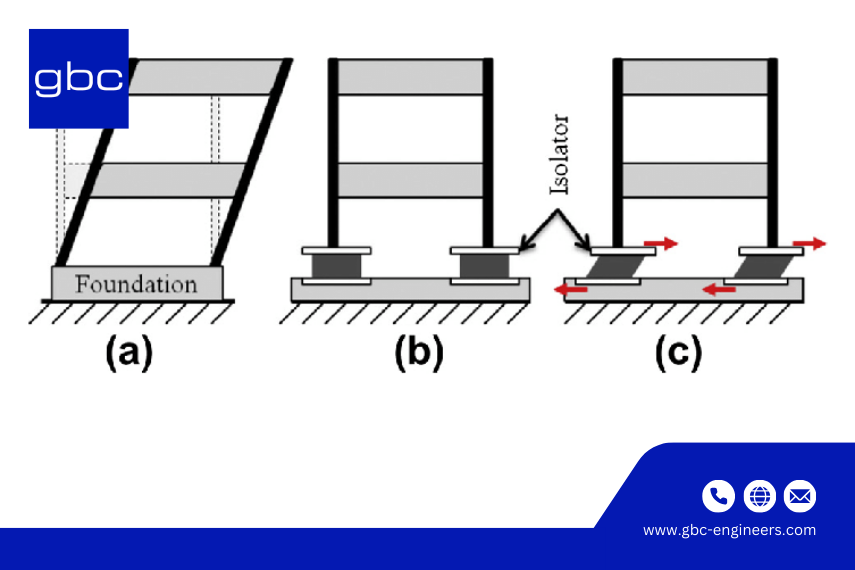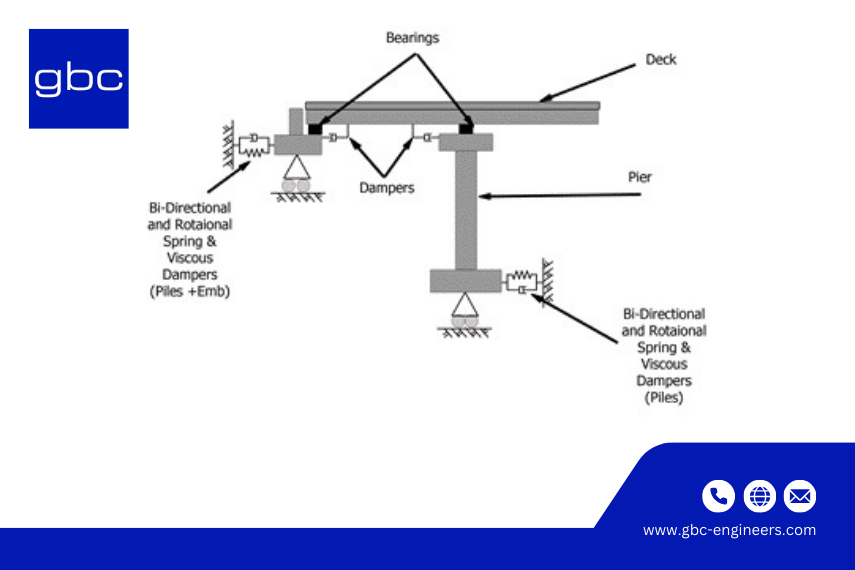Discover
earthquake-resistant design concepts with
gbc engineers. Learn how our expertise ensures safer, stronger buildings for Vietnam, Thailand, and Myanmar.
Why do some buildings collapses while others survive?
When it comes to seismic events, not all structures are created equal. Some constructions are designed to absorb the forces of an earthquake, while others aren’t.
1. Material Choice: Flexibility vs. Rigidity
In Southeast Asia, many structures are made of concrete and steel. Rigid materials like concrete may crack under the shaking forces of an earthquake. In contrast, flexible materials like steel allow structures to bend and absorb seismic energy without breaking. Flexible materials are especially important for structures in high-risk seismic areas.
2. Foundation Strength
The strength of a structure’s foundation is crucial. In places like Vietnam where structures are constructed on soft soil or reclaimed land (like parts of Hanoi), foundations need to be deeper and stronger to resist sinking or tilting during a seismic event. Without this, even the best-designed structure may be compromised.
3. Building Height and Shape
Taller structures, especially in Bangkok or Ho Chi Minh City, are more likely to sway during an earthquake. However, structures with odd shapes, like L-shaped or U-shaped designs, can twist and lead to uneven stress. This makes them more vulnerable, especially in areas with older structures or unusual designs.
4. Age of the Building
Older structures that weren’t designed with modern seismic standards are at greater risk. This is particularly concerning in Myanmar and Vietnam, where many structures have not been retrofitted with seismic-resistant features. Retrofitting older structures with modern technology can greatly improve their safety during a seismic event.

How Earthquakes Affect Different Types of Buildings
Short vs. Tall Buildings – Which ones are more at risk?
Both short structures (1-3 stories) and tall structures can be at risk in different ways. Short structures don’t sway as much as tall structures, but they can experience stronger shaking. Taller structures sway more, but if they’re not designed to handle that movement, they can face serious problems too.
Soft-Story Buildings – Why open spaces (like parking garages) are dangerous
Soft-story structures are those with open ground-floor spaces, like parking garages or stores. These structures are much more vulnerable during an earthquake because the ground floor can’t provide enough support to resist the shaking. Without reinforcement, these structures can collapse easily.
Irregular Shapes – How unusual building designs can lead to collapse
If a structure has an irregular shape, like an L or U shape, it’s more likely to twist during seismic events. This torsional motion can cause stress on the structure’s framework, leading to cracks or even collapse.
In Yangon, where older structures with unusual designs still exist, addressing this vulnerability is a major part of earthquake-proof design.
Structures Too Close Together – The danger of structures hitting each other
When structures are built too close to each other, they can collide during an earthquake. This is known as pounding, and it can cause significant damage. In highly populated cities like Bangkok or Hanoi, spacing between structures is crucial to prevent this kind of risk.

Earthquake-Resistant Design Concepts: How Engineers Keep Buildings Safe
Now that we understand how earthquakes affect structures, let’s dive into the innovative design concepts that help protect them and keep your home secure.
Base Isolation: Floating foundations that absorb shock
Base isolation involves placing flexible bearings beneath a building’s foundation. These bearings act like shock absorbers, allowing the building to move independently from the shaking ground. This helps the building stay intact during the earthquake.
Base isolators have been used in Hanoi and Bangkok, offering an extra layer of protection.

Damping Systems: Using mass dampers to counteract vibrations
Damping systems, like tuned mass dampers, reduce the amount of sway in tall structures during an earthquake. These systems are especially important for high-rise structures, like those in Ho Chi Minh City or Bangkok, where swaying can cause structural damage. By absorbing the structure’s movement, these dampers help keep structures stable and safe.

Reinforced Shear Walls & Cross-Bracing: Strengthening structural integrity
To resist lateral forces, engineers add reinforced shear walls (strong vertical walls) or cross-bracing (X-shaped braces) to structures. These reinforcements help the structure stay rigid and avoid collapsing during an earthquake.

Earthquake Building Codes: Ensuring Safety for All
Countries in Southeast Asia are strengthening their construction codes to make sure new structures are earthquake-resistant. Here’s a quick look:
Vietnam: The Vietnam National Standard (TCVN) includes regulations for seismic design.
Thailand: The Thai Seismic Design Code offers guidelines for earthquake-safe structures.
Myanmar: Myanmar is adopting international standards like Eurocode 8 to improve structural safety.

Let’s Build a Safer Future Together
At gbc engineers, we specialize in earthquake-resistant design and structural engineering system across Southeast Asia, with a focus on Vietnam, Thailand, and Myanmar. Our experienced team offers comprehensive solutions to ensure your structures are resilient to seismic forces under various conditions.
Our key services:
- Earthquake-Resistant Design: We design structures that can withstand earthquakes using advanced techniques like base isolation and reinforced shear walls.
- Seismic Retrofitting: Strengthen existing structures to meet modern earthquake standards.
- Structural Assessment: We assess your building’s vulnerability to earthquakes and optimize its safety.
- Sustainable Building Solutions: Combining earthquake resistance with eco-friendly and energy-efficient systems to create long-lasting structures that stand
- the test of time.
- BIM (Building Information Modeling): Using digital models to improve design and performance before construction.
Ready to Build Your Next-Generation Building?
Partner with gbc engineers to design a facility that delivers performance, reliability, and long-term value.
🌐 Visit: www.gbc-engineers.com
🏗️ Explore Our Services: Services - gbc engineers
As we’ve explored, earthquake-resistant design concepts are crucial for ensuring the safety and resilience of structures in regions prone to seismic activity. Contact gbc engineers today to learn how we can protect your projects with cutting-edge design.